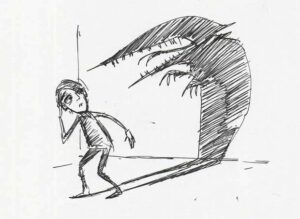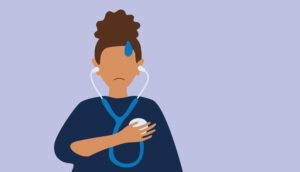Do you have intrusive thoughts that won’t go away no matter how much you try to push them out of your mind? If so, you are not alone. OCD intrusive thoughts are very common and can be quite debilitating. In this blog post, we will discuss the different types of intrusive thoughts, the connection between intrusive thoughts and compulsions, and how therapy can help.
Contents
OCD and Intrusive Thoughts
Obsessive-Compulsive Disorder (OCD) is an anxiety disorder that is characterized by intrusive thoughts, compulsions, and/or rituals. These thoughts, compulsions, and rituals can be extremely distressing and disruptive to one’s life.
Intrusive thoughts are defined as “any thought that repeatedly enters a person’s mind against their will and causes them distress.” Intrusive thoughts are often disturbing, graphic, or violent. They can be about anything that the person fears or worries about. For example, a person with OCD may have intrusive thoughts about harm coming to themselves or others, contamination, or making mistakes.
There is a strong connection between OCD and intrusive thoughts. Intrusive thoughts are one of the main symptoms of OCD. It is estimated that 95% of people with OCD experience intrusive thoughts.
Types of Intrusive Thoughts

Disturbing Images: Images that make you uncomfortable, such as visions of germs crawling on your body or the mental image of a commuter you pushed in front of a train.
Irrelevant Thoughts: Your mind may be dealing with thoughts and doubts, such as, “What if I killed someone and don’t remember it?”
Physical Impressions: It includes the impression that you have been contaminated by a public restroom or that your breathing has suddenly become erratic.
Unwanted and Perhaps False Recollections: It refers to the uncertainty of whether you accidentally touched a youngster inappropriately while playing with them.
Unwanted Urges: It depicts the need to touch objects a specific amount of times or check online to make sure your biography doesn’t match that of a serial murderer.
It also includes :
- Hearing voices
- Experiencing a sense of déjà vu
- Intrusive music
- Intrusive smells
The Connection Between Intrusive Thoughts and Compulsions

Intrusive thoughts are often followed by compulsions, which are behaviors or mental acts that a person feels they must do to reduce their anxiety or prevent something bad from happening. For example, a person with OCD may have an intrusive thought about harming someone and then feel the compulsion to wash their hands over and over again to “cleanse” themselves.
Compulsions are often done to reduce anxiety, but they end up reinforcing the OCD cycle. This is because the compulsions provide temporary relief from anxiety, which reinforces the belief that the compulsions are necessary to manage one’s anxiety. In reality, compulsions only serve to maintain and strengthen OCD.
For example, let’s say a person with OCD has an intrusive thought about harming their child. This may cause the person to feel a great deal of anxiety and fear. To reduce their anxiety, the person may engage in compulsive behavior such as checking on their child every five minutes to make sure they are safe. While this may provide temporary relief from anxiety, it reinforces the OCD cycle because it reaffirms the belief that the only way to reduce anxiety is to engage in compulsive behavior.
The Most Effective Treatment Options

Cognitive-Behavioural Therapy
Cognitive-Behavioral Therapy (CBT) is the most effective treatment for OCD. CBT is a type of therapy that helps people to change their thoughts, emotions, and behaviors. It emphasizes negative thoughts that give trigger bad emotions and various compulsions. To break the cycle of repetitive intrusive thoughts and compulsions, you need to learn how to manage your anxiety without using compulsions.
In CBT, you will work with a therapist to gradually expose yourself to the thoughts, emotions, and situations that you fear. This may be done through ‘imaginal exposure’, in which you imagine the feared situation. For example, if you are afraid of contamination, your therapist may have you imagine touching a doorknob or sitting on a public toilet seat.
Another method is ‘In vivo exposure’, in which you confront the feared situation in real life. For example, if you are afraid of contamination, your therapist may have you touch a doorknob and then not wash your hands for several hours.
CBT also teaches you how to use coping skills to manage anxiety. Coping skills are different from compulsions because they do not reinforce the OCD cycle. Instead, they help you to deal with anxiety. It is more effective than medication for treating OCD. It is also longer lasting, so there is less risk of relapse. If you are interested in CBT, you should ask your doctor if they know of a therapist who specializes in this type of therapy.
CBT for OCD focuses on exposure and response prevention (ERP). ERP is a type of CBT that involves gradually exposing oneself to fears and anxiety-provoking situations while simultaneously learning to resist engaging in compulsions.
ERP as a part of Cognitive Behavioural Therapy
The most prevalent behavioral therapy for OCD is called ERP (Exposure and Response Prevention). Exposure therapy makes use of actual or hypothetical exposure to objects or circumstances that give rise to obsessions that create anxiety. Following repeated exposure to certain triggers, anxiety starts to diminish until it never flares up when they are experienced again.
It has been demonstrated that cognitive behavioral therapy known as ERP therapy, or exposure and response prevention therapy is successful in treating OCD. ERP therapy helps patients resist the impulse to engage in compulsions by gradually exposing them to their concerns. It nudges you to confront your anxieties and allow obsessive thoughts to surface without “fixing” or “neutralizing” them with compulsions. The goal is to learn that the feared object or situation is not as dangerous as you think it is, and that anxiety will eventually go away on its own.
The Path of Self Care
If you don’t want to consult a mental health professional as of now, you can choose the path of ‘Self Care.
Below are some of the tips to help you control your intrusive thoughts:-
Stop changing the behavior
A significant step to stop changing your behavior is to try to reduce the anxiety caused by intrusive thoughts. This can be a difficult task as it can be very hard to not do the things that make us feel better in the short term. However, if we can manage to do this, it will be a big step in the right direction to reduce our anxiety in the long term. You might also make changes in your life. For instance, you might avoid parties if you have obsessive thoughts about children. These obsessive thoughts’ triggers are impossible to escape. This tactic merely perpetuates the cycle.
Identify how your thoughts disturb you
Things that are important to you tend to come up in intrusive thoughts. This is what causes your neurological system such a disturbance. It may be your reputation, your career, your family, or even your pets. If the thought occurs to you that you are harming an animal because you care about it, you will pay attention to it. If you didn’t care about the animal, the thought would not bother you as much.
Differentiate the thoughts between ‘Intrusive’ and ‘Normal’
It can be helpful to label the thoughts as “intrusive.” This will help you to remember that they are not accurate reflections of reality. The thoughts are just thoughts, and they do not have to control you. The fact that you have intrusive thoughts does not mean that you are a bad person. It is important to remember that everyone has intrusive thoughts, but people with OCD tend to get stuck on them.
Don’t take intrusive thoughts personally
Even though OCD thoughts are not real, we tend to believe them to the point where we apologize for things that never happened. It’s crucial to remember that your thoughts don’t necessarily reflect who you are. An emotional response to what you think only perpetuates the thought. The way we let go of normal thoughts, we need to follow the same way to dispose of the disturbing thoughts.
One of the main reasons why people with OCD can’t get rid of their intrusive thoughts is because they believe that having the thoughts means they will act on them. This is not true! Just because you have a thought, it doesn’t mean you will act on it. People with OCD are usually very opposed to acting on their intrusive thoughts. For example, people with OCD who are afraid of germs may have intrusive thoughts about contaminating themselves or others, but they would never actually do it.
Acceptance of OCD
The first step to getting rid of intrusive thoughts is to accept that they are a part of life. Everyone has them. We need to accept them as a part of life. Until and unless, one accepts them, he cannot change or control them. Also one should know that Obsessive Compulsive Disorder is chronic and it will not easily go away. It’s important to remember that just because you have an intrusive thought, it doesn’t mean you are going to act on it. Just let the thoughts come and go without paying too much attention to them.
Refocus your attention
When you have an intrusive thought, try to refocus your attention on something else. This can be anything that allows you to take your mind off of the intrusive thought. For example, you could:
- Read a book
- Watch a movie
- Take a walk
- Talk to a friend
- Listen to music
These activities will fill your mind with good thoughts that may outnumber the intrusive time over time. It will prove to be productive and beneficial in your life. You can also try out meditation and yoga to keep your mind calm and at peace.
Relaxation techniques
Relaxation techniques can be very helpful in managing intrusive thoughts. When you are feeling overwhelmed by intrusive thoughts, try one of these relaxation techniques:
Deep Breathing: Take a deep breath in through your nose, filling your lungs. Hold your breath for a few seconds before exhaling through your mouth.
Progressive muscle relaxation: Starting with your toes, tense each muscle group for five seconds before relaxing. Work your way up your body until you reach your head.
Visualization: Picture a peaceful scene in your mind. This could be a beach, a meadow, or any other place that makes you feel calm and relaxed.
Autogenic Relaxation: Repeat a phrase to yourself such as “My hands are heavy and warm” while focusing on the sensation of heaviness and warmth in your hands.
Talk to someone who understands
It can be very helpful to talk to someone who understands what you’re going through. This could be a therapist, a friend, or a family member. Talking about your intrusive thoughts can help to lessen their power over you. It can also help to know that you’re not alone in experiencing them. Talking out to someone can make you feel lighter emotionally. It’s never a wrong option to express your emotions to someone.
Follow the tips above to reduce the frequency of intrusive thoughts.
Conclusion
Intrusive thoughts are a part of life. Everyone has them. They are not something to be ashamed of. Remember that just because you have an intrusive thought, it doesn’t mean you are going to act on it. If you’re struggling to deal with intrusive thoughts, talk to a therapist or another trusted person who can help you manage them.
If you are struggling with OCD and its symptoms, you need to consult a therapist. We offer professional therapy services at an affordable price. With us, you get the finest online therapy altered to your needs or download our free OCD treatment app on Android or iOS.


